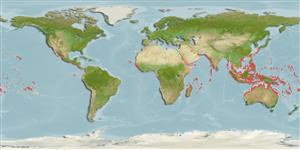>
Tetraodontiformes (Puffers and filefishes) >
Monacanthidae (Filefishes)
Etymology: Cantherhines: Greek, kanthos = the outer or inner corner of the eye, where the lids meet, 1646 + Greek, rhinos = nose (Ref. 45335).
More on author: Rüppell.
Environment: milieu / Zona climática / intervalo de profundidade / distribution range
Ecologia
marinhas associadas(os) a recifes; intervalo de profundidade 0 - 20 m (Ref. 9710). Tropical; 32°N - 32°S
Eastern Atlantic: Gulf of Guinea, Annobon Islands to south coast of Africa (Ref. 3592). Indo-Weat Pacific: South Africa to Red Sea (Ref. 4421) and east to southern Japan and southeastern Oceania. Replaced by Cantherhines sandwichiensis (Quoy & Gaimard 1824) in the Hawaiian Islands (Ref. 37816).
Tamanho / Peso / Idade
Maturidade: Lm ? range ? - ? cm
Max length : 25.0 cm TL macho/indeterminado; (Ref. 3592); common length : 15.0 cm TL macho/indeterminado; (Ref. 3467)
Descrição suscinta
Chaves de identificação | Morfologia | Morfometria
Espinhos dorsais (total) : 2; Raios dorsais (total) : 32 - 36; Espinhos anais: 0; Raios anais : 29 - 32. Can adopt three basic color patterns: mottled grey and brown, dark brown, or grey with a network of close-set polygonal spots. All have a small white spot at the rear base of the second dorsal fin and sometimes the anal fin.
Body shape (shape guide): short and / or deep.
Occurs on outer reef slopes to depths of 2 to more than 20 m (Ref. 1602, 48637), often silty habitats. Young float with loose surface weeds and adults are often with large Sargassum rafts during the wet season (Ref. 48637). Solitary. Feeds on benthic organisms (Ref. 30573). Somewhat secretive (Ref. 9710). Minimum depth reported taken from Ref. 128797.
Ciclo de vida ou comportamento de acasalamento
Maturidade | Reprodução | Desova | Ovos | Fecundidade | Larvas
Randall, J.E., G.R. Allen and R.C. Steene, 1990. Fishes of the Great Barrier Reef and Coral Sea. University of Hawaii Press, Honolulu, Hawaii. 506 p. (Ref. 2334)
Status na Lista Vermelha da UICN (Ref. 130435: Version 2025-1)
Ameaça para os humanos
Harmless
Uso pelos humanos
Pescarias: pouco comercial
Ferramentas
Relatórios especiais
Baixar XML
Fontes da internet
Estimates based on models
Preferred temperature (Ref.
123201): 24.7 - 29.3, mean 28.2 °C (based on 3455 cells).
Índice de diversidade filogenética (Ref.
82804): PD
50 = 0.5002 [Uniqueness, from 0.5 = low to 2.0 = high].
Bayesian length-weight: a=0.01585 (0.00918 - 0.02736), b=2.93 (2.78 - 3.08), in cm total length, based on LWR estimates for this species & (Sub)family-body (Ref.
93245).
Nível Trófico (Ref.
69278): 3.5 ±0.37 se; based on food items.
Resiliência (Ref.
120179): médio(a), tempo mínimo de duplicação da população 1,4 - 4,4 anos (Preliminary K or Fecundity.).
Fishing Vulnerability (Ref.
59153): Low vulnerability (15 of 100).
🛈
Nutrients (Ref.
124155): Calcium = 34.3 [10.0, 108.2] mg/100g; Iron = 0.832 [0.283, 2.230] mg/100g; Protein = 18.3 [16.1, 20.5] %; Omega3 = 0.0798 [, ] g/100g; Selenium = 36.1 [13.8, 97.3] μg/100g; VitaminA = 68.3 [19.9, 238.4] μg/100g; Zinc = 1.69 [0.77, 2.96] mg/100g (wet weight); based on
nutrient studies.
